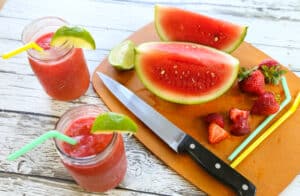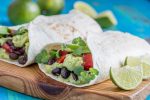For most people, drinking enough water is a constant struggle. It always seems like no matter how much water you drink, it’s still nowhere close to the recommended amount of eight glasses a day. And unless you want to walk around carrying a gallon of water all day to remind you to drink, it seems like you’ll never really get enough. In addition to worrying about how much water you drink, should you also be concerned about what type of water you drink? Some health experts argue that quality is just as important as quantity.

Mineral water claims to promote all sorts of health benefits, including lower blood pressure, better acid/alkaline balance in the body, and even weight loss. But is mineral water all it’s cracked up to be or just another gimmicky health hack that you don’t need to waste your money on? We’ve done the research and lay it all out in this article.
What Is Mineral Water?
Simply put, mineral water is water that contains several different minerals (duh, right?), such as magnesium, sodium, zinc, and calcium but it can also contain sulfur compounds. Mineral water can either be sparkling or “still” be depending on if there are any gasses added to it.

During our ancestor’s time, mineral water was usually consumed right at the source. Today, most mineral water is bottled at the source and then distributed throughout the world. Ths works better for society because you don’t have to seek an underground cave anymore if you want to consume mineral water. Research shows that there are more than 3,000 different brands of mineral water available for commercial use worldwide, so you definitely have your fair share to pick from.
Chemically speaking, the more magnesium and calcium found in mineral water, the harder it’s said to be. On the other hand, when mineral water contains lower amounts of calcium and magnesium, it’s referred to as soft. According to the United States Food and Drug Administration, mineral water must contain at least 250 parts per million total dissolved solids or TDS that come from a protected underground water source. You can’t add minerals to this water.

Keep in mind that some brands of mineral water refer to any bottled carbonated water or soda water, so you’ll want to make sure you know where your mineral water is sourced from. In Europe, mineral water is referred to as bottled water that has been bottled at the source. It must not undergo any treatment (or very little treatment) and it can be filtered to remove impurities as long as this process does not impact any of the water’s natural compounds.
Mineral Water Benefits
Research shows that drinking it is a good way to increase your mineral intake. In fact, you get as much as 10 to 15 percent of your daily recommended intake of calcium from tap water anyway. And because mineral water contains as much as four times the amount of minerals as tap water, you can be sure that you’re getting way more than a measly 15 percent when you drink it.

So, why are minerals important anyway? Well, even though your body only needs them in small amounts, minerals play a big role in maintaining your health. Here’s a breakdown of some of the ways your body uses the minerals in mineral water:
1. Calcium
Most people know that they need calcium for strong bones, but did you know that you also need calcium to reduce your risk of obesity and colon cancer? Pretty powerful stuff, huh? Research shows that calcium accounts for two percent of your total body weight as an adult. Most of the calcium in your body is stored in your teeth and bones, but there are also trace amounts located in your circulatory system. These are needed to prevent hemorrhages that could turn life-threatening. Calcium has also been shown to :

● Help maintain healthy gums, teeth, and bones
● Strengthen the backbone, which can help alleviate back pain
● Keep bones in their proper shape
● Prevent osteoporosis and arthritis
● Aid in weight loss
● Protect your heart muscles
● Maintain a healthy blood pressure
● Suppress the growth of polyps that may cause cancer
● Reduce depression and mood swings associated with PMS
● Prevent kidney stones
● Contribute to acid/alkaline balance
● Transport nutrients across your cell membranes
That’s a lot of responsibility for one little mineral, and if you’re lactose intolerant or don’t eat dairy, then you could missing out. Drinking mineral water is a great way to get your calcium intake up.
2. Magnesium

If you thought your magnesium levels didn’t matter, think again. Magnesium is needed in more than 600 chemical reactions in your body, including protein formation, energy production, the maintenance of your genes, muscle movements, and regulation of the nervous system. Research shows that you also need magnesium to:
● Fight depression
● Boost exercise performance
● Protect against type 2 diabetes
● Lower blood pressure
● Reduce inflammation (which helps reduce pain and autoimmune symptoms)
● Prevent migraines
● Reduce insulin resistance
● Improve PMS symptoms
In other words, you’d have a tough time calling yourself healthy without magnesium in your diet. Sadly, research shows that as many as half of the population in the United States and Europe don’t get enough magnesium. Drinking mineral water is an excellent way to make sure you get your daily intake of magnesium in while staying hydrated, too. You’ll feel more energized, happier, and your body will work better.

Zinc is an essential trace mineral needed in small amounts only, but it has a lot of jobs, including helping with hormone production, immunity, digestion, growth and development, and disease prevention. Did you know that zinc has anti-inflammatory properties and can even fight cancer and heart disease? Yep, that’s zinc for you. If you feel run down, tired all the time no matter how much you sleep, have problems recovering from infections or wounds, or suffer from poor concentration levels, then you might have low levels of zinc.
The post Is Mineral Water Worth the Extra Cost? Find out Here appeared first on Health Wholeness.
from Health Wholeness https://ift.tt/2OiY1W2



















